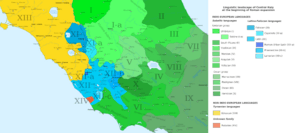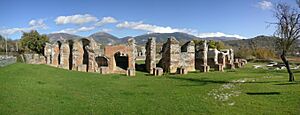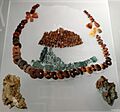Sabines facts for kids
The Sabines were an ancient people who lived in the central mountains of Italy. Their land was called Sabina. Before the city of Rome was founded, some Sabines also lived in an area north of the Anio River in Latium.
After Rome was founded, the Sabines split into two groups. One group moved to the new city of Rome and joined its people. They became part of the Romans, but still kept some of their Sabine heritage. The other group stayed in the mountains as a tribal state. They later fought against Rome for their freedom, along with other Italian tribes. Eventually, they became part of the Roman Republic.
Contents
What Language Did They Speak?
We don't have many records of the Sabine language. However, some ancient writers mentioned a few Sabine words. There are also some names on old Latin stone carvings from the Sabine area.
Experts believe the Sabine language was part of the Umbrian group of Italic languages. This means it was related to languages like Umbrian, which were part of the larger Indo-European language family.
Quick facts for kids Sabine |
||||
|---|---|---|---|---|
| lingua Sabina | ||||
| Pronunciation | [saˈbiːna] | |||
| Native to | Sabina (Sabinum) | |||
| Region | Central Italy | |||
| Ethnicity | Sabines | |||
| Extinct | Only traces of vocabulary, mainly from Marcus Terentius Varro, 1st century BC | |||
| Language family |
Indo-European
|
|||
| Writing system | Latin alphabet | |||
| Linguist List | sbv | |||

The linguistic landscape of Central Italy at the beginning of Roman expansion
|
||||

Map showing the location of the Sabines. The border with Latium to the south was the Aniene river; however, it is possible that Sabines extended to Lake Regillus slightly to the south of it near Gabii.
|
||||
|
||||
Where Did the Sabines Live?
The Sabines' original land was called Sabinum by Latin speakers. This area is now part of the modern regions of Lazio, Umbria, and Abruzzo in Italy. Even today, this area is called Sabina in Italian. Within the Lazio region, Sabina is a smaller area located northeast of Rome, near the city of Rieti.
Sabine History
How the Sabines Began
The Sabines settled in the Sabinum region around 1000 BC. They founded cities like Reate, Trebula Mutuesca, and Cures Sabini. Some ancient historians had different ideas about where the Sabines came from.
One idea is that the Sabines moved to the land of the Opici people after a long war with the Umbrians. They followed an old Italian tradition called Ver Sacrum, which means "sacred spring." This tradition involved young people leaving their homes to find new lands. The Sabines then drove out the Opici and settled in that area.
Another story says that the Sabines were originally Umbrians who changed their name. Some believed they were named after Sabus, the son of a god named Sancus.
There's also a story that a group of people from Sparta (an ancient Greek city) came to Italy. They founded a colony and some of them settled among the Sabines. This story suggests that the Sabines' warlike and thrifty habits came from the Spartans.
Sabines and Rome
The Legend of the Sabine Women
One famous legend tells how the Romans got their wives. Rome was a new city, and it needed more people, especially women. So, the Romans invited the Sabines to a festival. During the festival, the Romans suddenly captured many Sabine women. This event is known as the "Rape of the Sabine Women."
This act led to a war between the Romans and the Sabines. The war ended when the Sabine women, who now had children with their Roman husbands, bravely stepped between the two armies. They begged their fathers and husbands to stop fighting. Because of the women, the two sides made peace.
According to the historian Livy, after this conflict, the Sabine and Roman states joined together. The Sabine king, Titus Tatius, ruled Rome alongside Romulus, the founder of Rome. They ruled together for five years until Tatius died.
Sabine Traditions in Rome
Many traditions suggest that the early Roman kingdom was a mix of Sabines and other peoples. Some important Roman families were proud of their Sabine background. For example, the Claudia family often used "Sabinus" as part of their name.
Some Sabine gods and religious practices also became part of Roman life. Gods like Semo Sancus and Quirinus were important in Rome. The Quirinal Hill in Rome, where temples to these gods were located, was once a Sabine area. Some Roman customs, like predicting the future by studying birds (augury) and worshipping certain gods, were believed to have come from the Sabines. This was especially true because Numa Pompilius, the second king of Rome, was a Sabine.
Sabine Gods
The Sabines worshipped many gods, and many of these were also worshipped by the Etruscans and later by the Romans. Here are some of them:
- Angitia
- Diana
- Feronia
- Fortuna
- Fons
- Fides
- Flora
- Herentas (like Venus)
- Lares (guardian gods)
- Larunda
- Lucina
- Luna
- Mamers (like Mars)
- Mefitis
- Minerva
- Novensides (council of thunder gods)
- Ops
- Pales
- Quirinus
- Sabus
- Salus
- Sancus
- Saturn
- Sol
- Soranus
- Strenia
- Summanus
- Terminus
- Vacuna
- Vediovis
- Vortumnus
- Vitula
- Vulcan
The Roman writer Varro, who had Sabine family roots, listed many Sabine gods that the Romans adopted. He even suggested that some gods, like Saturn and Diana, had Sabine origins. The importance of the Sabines in early Roman culture is clear from stories like the Sabine women and the fact that Numa Pompilius, a Sabine, became Rome's second king.
Sabine State and Rome
As ancient Rome grew, it had several conflicts with the Sabines. Eventually, in 290 BC, a Roman leader named Manius Curius Dentatus conquered the Sabines.
After their defeat, the Sabines were given a special kind of Roman citizenship. They became citizens but did not have the right to vote at first. Later, in 268 BC, they were granted the full right to vote. This shows how the Sabines gradually became a part of the Roman state.
Important Sabines
Roman Families with Sabine Roots
Many important Roman families, called gentes, had Sabine origins. This shows how much the Sabines contributed to the Roman population. Some of these families include:
- Aemilia gens
- Aurelia gens
- Calpurnia gens
- Claudia gens
- Flavia gens
- Marcia gens
- Pompilia gens
- Pomponia gens
- Valeria gens
Famous Romans of Sabine Ancestry
Several well-known figures in Roman history had Sabine ancestors:
- Titus Tatius: A legendary king of the Sabines who ruled Rome with Romulus.
- Numa Pompilius: The legendary second king of Rome, known for setting up many Roman laws and religious customs.
- Ancus Marcius: Another legendary king of Rome.
- Quintus Sertorius: A famous Roman general.
- Vespasian: A Roman emperor who founded the Flavian dynasty.
- Marcus Terentius Varro: A famous Roman scholar and writer.
Images for kids
See also
- Ancient peoples of Italy
- Hostus Hostilius








